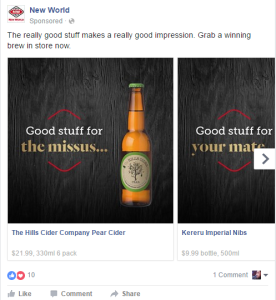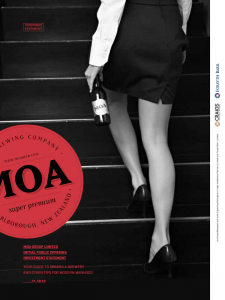A hopefully-exhaustive summary for the apparently-perplexed:
Q — When should I use gender tropes in pitching my product and in the targeting or tailoring of my marketing?
A — Never.1
Footnotes:
1: That should do it for this topic. It isn’t complicated. We shouldn’t need to keep having this conversation. Seemingly inevitably, though, it came around again just recently and doubtless it will do so once more soon enough. I’ve been in the beer-selling business for a decade now and I’m still not sure things are improving. So fine. I’ll elaborate, if I must.

My argument is fairly simple: you should only rely on gender in the marketing of products which are sought out or consumed in a way that implicates gender. And there are vanishingly few such cases. So unless there is a pressing need and unarguable relevance, just leave gender out of the sales pitch.
I remember an old piece of advice (offered jokingly to marketers on funny-because-true grounds) along the lines of condoms and tampons being the only things that need to be advertised with gender in mind, but even that falls apart when you think more deeply about the real world — and if “genitalia ≠ gender” is news to you, then a) you should get out more (if you need it, there’s an excellent explainer over at the Wireless), and b) you are distinctly unqualified to market things that involve either. Gender is a social concept, and doesn’t really tell you anything else about the person or what they like or what they do. The only references that work are very thin ones: pitching a World’s Greatest Dad mug as a Father’s Day gift makes sense, but dad-ness doesn’t imply that beer would be a better present than cider or wine or whisky.
The needless gendering of cider has an extra layer of Boring Old Sexism to it, but all of the ‘pitches’ in New World’s campaign fail (as ads) for precisely the same reason. There’s nothing about someone being “your mate” that suggests they’d like an imperial porter. People just don’t use their demographics to enjoy things. They use their senses and their surroundings. There are plenty of levers there on which to hang an ad or an enticement: the porter is for lovers of chocolate, or sharing over dessert, or for the depths of winter — just to cite three easy and obvious first drafts. (Replacement ads for New World’s campaign quickly surfaced that centered on food matching. It’s not difficult.)

Statistics is then the last refuge of the clueless, here. People will rush to defend a company marketing their fruit beer or cider in clumsily feminine terms on the grounds that that’s what women do buy. These claims are typically woefully short on actual data, and even though I don’t have any of my own to pre-empt that particular battle I can honestly say that years of bartending leaves me skeptical there’s really much to it. Women drink beer. Men drink cider. Women drink whisky. Men drink wine. None of these things are news. Any patterns are certainly not so drastic that it makes commercial sense to lock them in, rather than try to broaden your reach. Mystification at having their money often ignored was a common theme from the four beer-loving women who took over the podcast here a while back (the episodes are here and here). And even if there’s a gender-based pattern in some direction in some subset of the market, does it seem more likely that generations of boring old sexist advertisers have discovered a scientific fact about flavour preferences — or that they’ve gradually created the very thing they’re now citing to hide behind? I have my suspicions. An agency resorting to these ways of characterising their customers are unimaginative throwbacks who succeed only in the relatively-rare combination of doing bad ethics and bad capitalism at the same time.
Helpful and non-horrible beer marketing is easy: focus on the drink, not your weird assumptions about the drinker. It’s not about “not offending people” — although being a decent human being is certainly a welcome bonus — it’s just a matter of providing information people can actually use, rather than noise derived from old habits. Tell us the story of what you’ve made; talk about flavours and process and provenance. We’re quite capable of taking things from there and deciding whether or not we’d like to try it.


This sort of stuff goes right up to the bar. Apparently (according to some bar tenders), I’m allowed to order whatever I want, but my girlfriend often gets a “sure you can handle that” when ordering a double IPA… not always, but often.
I couldn’t agree more! This was definitely aimed at the stages in the chain before that; the breweries and their marketing agencies and such. But yes. Thankfully, the bars I’ve worked in have always been willing to push back against the gendering of beer, even by their customers. It’s not an easy thing to do, but it’s worth trying.
This happens to us all the time. I’m quite varied in my beer choices, but Kate prefers IPAs that will strip the enamel from your teeth. I can’t count the times we’ve ordered a wheat beer and an IPA and either got the “are you sure” warning or they’ve been placed in front of the wrong person when they’re delivered to the table.
Phil this is such a great issue to address and I thoroughly enjoyed your article in The Pursuit of Hoppiness recently also. This antiquated form of marketing and thinking I agree is ‘alarming and depressing’ to say the least! If marketers and those in the industry want to ignore half of the market, more fool them! Thanks Phil for your well worded articles!!
I recently read your article in the Pursuit of Hoppiness and had to come read the footnote you referenced. I wholeheartedly agree that marketing stereotypes (especially when it comes to alcohol) are so wrong! I went to the recent GABS festival in Auckland with my cousin (who is also female) and was really pleased to see there was a good representation of all genders in attendance – maybe all those marketers should take note. As a women who brews and enjoys all types of beer, it will be great to see these attitudes shift as more people speak out about it. Thanks for encouraging a change in attitude on this topic!